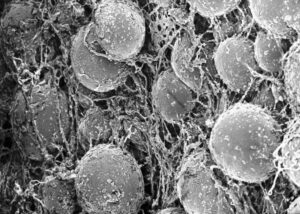Introduction
Adipose tissue progenitor cells directly interact with endothelial cells to induce vascular network formation. Adipose Tissue regulates the production of hormones, angiogenic factors, and cytokines. During the development of obesity, Adipose Tissue expands through the increase in fat cell size (hypertrophy) and/or fat cell number (hyperplasia). Adipose Tissue Endothelial Cell Interactions are necessary to study Obesity-Induced Endothelial Dysfunction.
The plasticity and expansion of Adipose Tissue are related to its angiogenic capacities. Angiogenesis is a tightly orchestrated process, which involves endothelial cell (EC) proliferation, migration, invasion, and new tube formation. The expansion of Adipose Tissue is accelerated by hypoxia, inflammation, and structural remodeling of blood vessels. The paracrine signaling regulates the functional link between Endothelial Cells and Adipocytes.
The paper below tells us about how obesity induces endothelial dysfunction, which often precedes and leads to the development of cardiovascular diseases. Adipose-to-endothelial cell interaction may help us comprehend obesity-induced cardiovascular disease more effectively.

How to culture vascularized & immunocompetent 3D models in a standard Multiwell
Abstract of Adipose Tissue-Endothelial Cell Interactions in Obesity-Induced Endothelial Dysfunction
The authors state that “Obesity has a strong impact on the pathogenesis of the cardiovascular disease, which raises enthusiasm to understand how excess adiposity causes vascular injury. Adipose tissue is an essential regulator of the cardiovascular system through its endocrine and paracrine bioactive products.
Obesity induces endothelial dysfunction, which often precedes and leads to the development of cardiovascular diseases. Connecting adipose tissue-endothelial cell interplay to endothelial dysfunction may help us to better understand obesity-induced cardiovascular disease.
This Mini-Review discussed (1) the general interactions and obesity-induced endothelial dysfunction, (2) potential targets, and (3) the outstanding questions for future research.”
References
Li M, Qian M, Kyler K, Xu J. Adipose Tissue-Endothelial Cell Interactions in Obesity-Induced Endothelial Dysfunction. Front Cardiovasc Med. 2021 Jul 1;8:681581. DOI: 10.3389/fcvm.2021.681581. PMID: 34277732; PMCID: PMC8282205.
FAQ
Adipose tissue is involved in regulating the cardiovascular system. This regulation is achieved through its bioactive products, which are both endocrine and paracrine. The tissue also controls the production of hormones. Additionally, angiogenic factors and cytokines are regulated by adipose tissue. Adipose tissue progenitor cells have a direct interaction with endothelial cells. This specific interaction is what induces the formation of vascular networks. The functional connection between adipocytes and endothelial cells is regulated by paracrine signaling. The tissue’s ability to expand and change, its plasticity, is related to its angiogenic capacities. This process of angiogenesis involves endothelial cell proliferation, migration, and the formation of new tubes.
During the development of obesity, adipose tissue, or AT, undergoes expansion. This expansion happens in two ways. It can occur through an increase in the size of the fat cells, which is called hypertrophy. It can also happen through an increase in the number of fat cells, known as hyperplasia. The expansion and plasticity of adipose tissue are related to its angiogenic capacities. This process of angiogenesis is tightly orchestrated. It involves the proliferation, migration, and invasion of endothelial cells. New tube formation is also part of the process. Several factors are known to accelerate the expansion of adipose tissue. These factors include hypoxia, inflammation, and the structural remodeling of blood vessels.
Obesity has a strong effect on the pathogenesis of cardiovascular disease. This has led to interest in understanding how excess adiposity can cause vascular injury. It is known that obesity induces endothelial dysfunction. This dysfunction is a condition that often precedes cardiovascular diseases. It also frequently leads to their development. Adipose tissue is a regulator of the cardiovascular system, acting through its endocrine and paracrine products. A better understanding of obesity-induced cardiovascular disease may be gained by studying the adipose-to-endothelial cell interaction. This connection between the cell interplay and endothelial dysfunction is a focus of research.
The interactions between adipose tissue and endothelial cells are considered necessary to study. This is because they help in understanding obesity-induced endothelial dysfunction. This dysfunction is an important condition, as it often precedes and leads to cardiovascular diseases. Obesity’s effect on cardiovascular disease has raised interest in learning how excess adiposity causes vascular injury. Connecting the interplay between these cells to the dysfunction may help us better comprehend these conditions. Research in this area discusses the general interactions. It also covers the endothelial dysfunction caused by obesity. The research also identifies potential targets and outstanding questions for future study.





